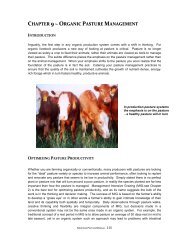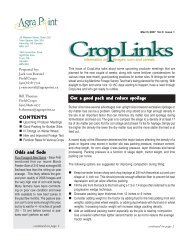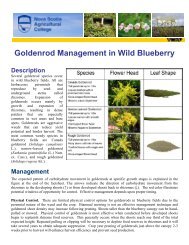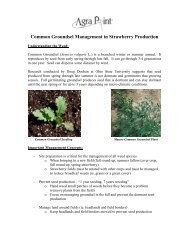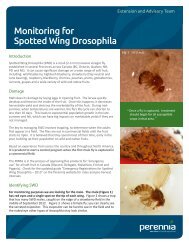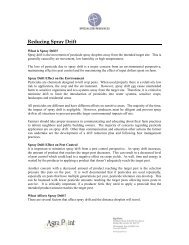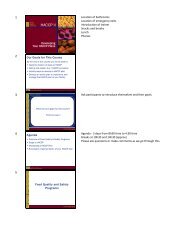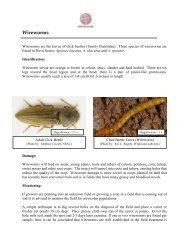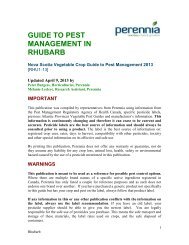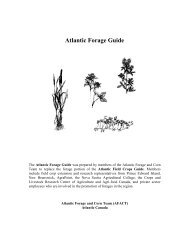Create successful ePaper yourself
Turn your PDF publications into a flip-book with our unique Google optimized e-Paper software.
Questions from the <strong>Farm</strong><br />
FARMER<br />
LEAD<br />
RESEARCH<br />
Low cost research<br />
Scientifically<br />
robust<br />
Specific to your<br />
farm<br />
Designed and lead<br />
by you with a little<br />
help from us<br />
INSIDE<br />
THIS ISSUE:<br />
The approach 2<br />
Observations<br />
&<br />
Measurements 2<br />
The meaning<br />
of it all 3<br />
Costs involved 3<br />
Discussion 3<br />
Benefits of onfarm<br />
research 4<br />
Volume 1, Issue 1<br />
<strong>Black</strong> <strong>Avon</strong> <strong>Farm</strong><br />
Tony and Erica Versteeg<br />
are a progressive young<br />
couple who recently<br />
purchased <strong>Black</strong> <strong>Avon</strong><br />
<strong>Farm</strong> near Heatherton<br />
in Antigonish county.<br />
Although the couple maybe<br />
relatively new to Antigonish<br />
county, they are certainly<br />
not new to agriculture. Both<br />
grew up on farms and met<br />
at the Agricultural College<br />
where Erica was attaining<br />
a degree in Agricultural<br />
Business and Tony in<br />
<strong>Farm</strong> Mechanization.<br />
After graduation, Erica<br />
began working as an<br />
Environmental <strong>Farm</strong><br />
Planning Coordinator<br />
and Tony worked as a<br />
production supervisor at a<br />
producer-owned dairy as<br />
well as being employed on<br />
a number of dairy farms<br />
within the province.<br />
With their combined<br />
experience and ambition<br />
they set their sights on one<br />
Tony and Erica<br />
Versteeg of<br />
<strong>Black</strong> <strong>Avon</strong><br />
<strong>Farm</strong> with their<br />
best farm hands.<br />
September 2012<br />
day owning a dairy farm.<br />
In 2010, they purchased<br />
<strong>Black</strong> <strong>Avon</strong> <strong>Farm</strong>s where<br />
they currently reside with<br />
their young family.<br />
<strong>Black</strong> <strong>Avon</strong> <strong>Farm</strong> is a<br />
104 ha dairy operation<br />
milking approximately<br />
70 lactating cows. The<br />
farm is primarily forage<br />
based. The farm consists<br />
of a mosaic of soil series<br />
including Merigomish<br />
(sandy loam), Woodbourne<br />
(gravely loam to sandy<br />
loam), Queens (clay loam),<br />
Stewiacke (silt loam) and<br />
some edges of fields line<br />
the Herbert (sandy loam)<br />
series. These soils present<br />
a full spectrum in drainage<br />
capability of each field.<br />
Where are the soil nutrients after fall incorporated manure?<br />
The Question<br />
Conventional soil testing relies<br />
on an approach designed to<br />
determine a single rate of nutrient<br />
application ignoring variability<br />
within the field. While precision<br />
agriculture has attempted to<br />
circumvent this by addressing the<br />
variability of soil nutrients on the<br />
surface, variability with soil depth<br />
is often ignored. Soil nutrients from<br />
surface applied manure can be<br />
inverted by plowing. Plowing has<br />
been shown to reduce soil nutrient<br />
content near the surface and to<br />
redistribute nutrients within the top<br />
15 cm of soil. Recommendations<br />
to add a spring starter fertilizer<br />
The <strong>Farm</strong><br />
to fall plowed fields despite soil tests<br />
showing adequate soil nutrients are often<br />
recommended because the assumption<br />
is that the majority of the nutrients have<br />
been buried and are below the root zone<br />
of newly seeded crops. Conventional<br />
soil testing at <strong>Black</strong> <strong>Avon</strong> <strong>Farm</strong> indicated<br />
that soil nutrients were high, indicating<br />
there would not be an economic return to<br />
spring fertilizer application. However, this<br />
rating was an average of the top 15 cm<br />
of soil. The objective of this experiment<br />
was to determine whether there were<br />
differences in soil nutrients, with depth,<br />
after fall applied manure which was fall<br />
incorporated by plowing in a high fertility<br />
field.
PAGE 2<br />
A soil core 25<br />
cm long was<br />
collected and<br />
divided into<br />
five different<br />
depths<br />
“Realistic<br />
questions,<br />
practical<br />
solutions -<br />
that’s what<br />
farmer lead<br />
research is<br />
all about.”<br />
- Amy<br />
Sangster<br />
How the question was approached<br />
The site was a 3.2 ha field in that was to be seeded to a 40 % timothy, 60 %<br />
alfalfa mix. The soil is a Woodbourne type soil; a gravelly loam to sandy loam<br />
over gravelly clay loam soil. A composite soil sample was taken randomly across<br />
the field to a depth of 15 cm before manure was spread in the fall. A subsample<br />
was sent to the Nova Scotia Department of Agriculture analytical lab for analysis.<br />
The soil test determined that the pH was 6.8, phosphorous was rated high at 298<br />
kg/ha and potassium was also rated high at 320 kg/ha. The field was previously<br />
in unimproved grass for a number of years. Manure was spread in the fall of 2011<br />
at a rate of 30 tonne /ha and was incorporated by moldboard plow. The following<br />
spring, before planting and before additional fertility amendments were added, the<br />
field was resampled at depths of 0-5 cm, 5-10 cm, 10-15 cm, 15-20 cm and 20-<br />
25 cm. For each depth, 30 sub samples were taken across the field in a random<br />
pattern. The samples were compiled for each depth, mixed well and then a sub<br />
sample was taken from the composite and sent for analysis.<br />
Observations and Measurements<br />
Soil sampling in<br />
the field for the<br />
five depths took<br />
about 1.5 hours<br />
Soil testing to 15 cm<br />
last fall before manure<br />
application indicated that<br />
plant available nutrients<br />
levels were 298 kg/ha<br />
for P 2<br />
O 5<br />
(phosphorous<br />
rated as H) and 320 kg/<br />
ha for K 2<br />
O (potassium<br />
rated as H) and the<br />
soil pH was 6.5. Both<br />
of these levels rated<br />
as high (H). Organic<br />
matter levels were 4.9<br />
%. Based on the results<br />
of the samples taken<br />
at 5 cm increments in<br />
the spring, after manure<br />
application and plowing,<br />
there did appear to be<br />
an inversion effect of<br />
nutrients. The highest<br />
levels of nutrients were<br />
found between 10-15<br />
cm. Nutrients were<br />
rated “high” at the 15-20<br />
cm depth and the levels<br />
at this depth were higher<br />
than at the soil surface.<br />
The lowest nutrient<br />
levels were found at the<br />
20-25 cm depth.<br />
QUESTIONS FROM THE FARM
Volume 1, Issue 1<br />
PAGE 3<br />
What does it all mean?<br />
Ideally, adequate<br />
nutrients should be<br />
within the root zone of<br />
the developing plant.<br />
The majority of root<br />
concentration lies within<br />
the first 5 cm of soil.<br />
Because of the nutrient<br />
inversion effect, <strong>Black</strong><br />
<strong>Avon</strong> <strong>Farm</strong>s followed<br />
their fall applied manure<br />
with a top up application<br />
of manure which was<br />
applied in the spring<br />
before planting. This<br />
would place nutrients<br />
in the first 5 cm of soil<br />
What did it cost?<br />
and ensure there were<br />
adequate nutrients for<br />
the growing seedlings.<br />
Timothy roots tend to be<br />
relatively shallow with<br />
80% of the roots in the<br />
top 5 cm but mature<br />
stands of alfalfa have<br />
been reported to have<br />
tap roots extending<br />
9 meters or more, so<br />
nutrients at depth can<br />
be utilized as the plant<br />
develops. In fact, the<br />
buried nutrients may<br />
provide potassium to<br />
the alfalfa that would<br />
be accessed<br />
by the plants<br />
later in the<br />
season when<br />
roots are more<br />
developed. Potassium<br />
is important for winter<br />
hardiness. Although soil<br />
nutrient levels at <strong>Black</strong><br />
<strong>Avon</strong> <strong>Farm</strong> were rated<br />
as high, it is important<br />
to reapply nutrients to<br />
maintain good levels.<br />
Every time a crop is<br />
removed, significant<br />
nutrients are also<br />
removed from that field.<br />
Soil samples cost registered farms $12.35 per sample ($24.70 for non registered<br />
farms). Since only one sub sample was sent for each depth and samples were<br />
taken at 5 different depths the total lab cost for this experiment was only $61.75.<br />
The time taken to do the sampling was approximately 1.5 hours with another 0.5<br />
hours to look at the reports and determine what they meant. If the hourly rate<br />
for the sampling was estimated as $12/hr and if the farm managers time was<br />
estimated at $25/hr to review the report, then the total cost of the experiment<br />
including time was $ 92.25.<br />
It is difficult to put a dollar value on the value of the information gained. If nutrient<br />
values were adjusted according to the results fertilizer cost could actually<br />
increase initially. However, ensuring that there are proper levels of nutrients<br />
for the germinating seedling within that first 5 cm of soil should translate into a<br />
stronger establishment, a healthier plant, and theoretically that should translate<br />
into greater yields and a better plant quality.<br />
Variability in a<br />
field also occurs<br />
with depth<br />
The quick and<br />
‘dirty’ answer<br />
to <strong>Black</strong> <strong>Avon</strong>’s<br />
question:<br />
The highest<br />
levels of<br />
nutrients<br />
were found<br />
at a depth of<br />
10-15 cm.<br />
Discussion<br />
Manure application to alfalfa is always met with some debate because it may over<br />
supply nitrogen which discourages the alfalfa plant from fixing its own nitrogen<br />
from the atmosphere (free fertilizer). However, alfalfa has a heavy requirement<br />
for phosphorous and potassium and has been shown to respond favorably to<br />
well-timed manure applications. Applying manure before seeding rather than after<br />
the stand is established, prevents mechanical damage to the alfalfa crowns which<br />
can reduce the persistence of alfalfa in mixed stands.<br />
How much manure to apply will depend on the existing soil fertility and the<br />
demands of the crop. A 8 t/ha dry matter yield of a 70:30 alfalfa:timothy mix can<br />
remove approximately 121 kgs/ha of P 2<br />
O 5<br />
(phosphorous), 661 kgs/ha of K 2<br />
O<br />
(potassium) and 94 kgs/ha of nitrogen (assuming alfalfa is fixing most of its<br />
nitrogen).<br />
Timing, rate<br />
and source of<br />
nutrients can<br />
have a significant<br />
effect on<br />
the health of a<br />
crop
About <strong>Perennia</strong><br />
<strong>Perennia</strong> is a fully integrated agri-food and bio-resource company with<br />
integrated teams in extension and advisory services, quality and food safety,<br />
bioventures, and facilities. Specialists work with producers and processors to<br />
address production issues on farms, create internationally recognized quality<br />
and food safety programs, provide leased incubation space for new product<br />
development, and conduct research to transform underutilized land- and<br />
marine-based resources into high-value products.<br />
<strong>Perennia</strong> combines the resources of AgraPoint, the Atlantic BioVenture Centre<br />
and AgriTECH Park.<br />
Y<br />
Benefits of On-farm Research<br />
Why do we stop asking why? Even a toddler can recognize that, “because<br />
I said so” is not necessarily the best answer to the question. On-farm<br />
research is quite simply about asking questions and finding good answers<br />
that are meaningful to your farm. It’s about real questions in real life<br />
situations. It’s a process. It‘s a process that has benefits beyond just the<br />
findings. Conducting your own on farm research project will sharpen your<br />
observational skills, better enable you to assess the applicability of advice,<br />
allow you to get to know your farm even better, and help you make more<br />
confident decisions about changes on your farm.<br />
Where do we come in? At <strong>Perennia</strong>, we can:<br />
• help you design the process to ensure your questions can be answered in<br />
a practical, meaningful, and cost effective manner<br />
• provide background information and relay findings to similar questions that<br />
have been asked<br />
• serve as a resource throughout the project<br />
• help compile the information collected, and produce a straightforward<br />
report that you and your neighbours can refer to<br />
• help organize and host a workshop to share your findings<br />
Research shouldn’t be restricted to the lab or to small field plots. Everyone<br />
can ask the question “Why”.<br />
Your question,<br />
your answers, and<br />
a little bit of our<br />
help<br />
32 Main Street<br />
Kentville, NS<br />
B4N 1J5<br />
Extension and Food Safety<br />
Phone 902 678 7722<br />
Fax 902 678 7266<br />
90 Research Drive<br />
Bible Hill, NS<br />
B6L 2R2<br />
Facilities and BioVentures<br />
Phone 902 896 7270<br />
Fax 902 896 7276<br />
Extension and Food Safety<br />
Phone 902 896 0277<br />
Fax 902 896 7299<br />
Innovation Centre<br />
Phone 902 896 8782<br />
Fax 902 896 8781<br />
Food Safety - New Brunswick<br />
Phone 506 433 8155<br />
Fax 506 433 5689<br />
www.perennia.ca<br />
nsperennia<br />
NS<strong>Perennia</strong>



